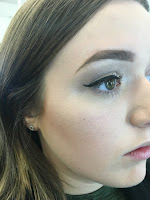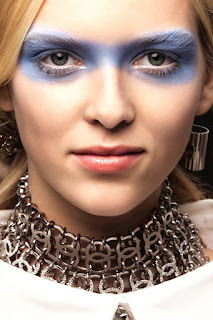"Packaging is powerful. It's not just what's on shelf that matters, but the unveiling process as well. The layers, the textures, the moment of anticipation, et voila." Rob Repta, Senior Designer and Social Media Strategist at Design Packaging, Inc
Nothing speaks to classic sophistication like the minimal black and white Chanel packaging. Luxury branding after all is all about simple, subtle, and understated quality. So I was surprised to find out where the inspiration for the interlocking "C" logo icon came from. Voguepedia reports that after Coco Chanel's mother died at age 31, "Gabrielle’s father sends his three daughters to the convent of Aubazine, where the nuns teach her discipline—and sewing. "The interlocking ‘C’ logo closely resembles the curved patterns featured in the stained glass windows of the church where she spent her childhood in an orphanage.
The black and white box design that houses Chanel No5 is the same as the original packaging used in 1921. Through Chanel packaging she shows a classic and timeless look for her products using the sophisticated look of black and white which could never out date.
This September, the HBA Global Expo will award its "Packaging Executive of the Year" award to Scott Widro, v.p. of materials management and manufacturing, Chanel. Widro's counterpart in Paris is Michel Dupuis, senior v.p. of package development in the Paris headquarters. The secret to Chanel's package design success is having long-term relationships with a relatively small number of suppliers and converters and having close control on every aspect of product and package production.
For instance, global launches are truly global launches of a singularly consistent product and package, coordinated to appear nearly simultaneously around the world. Dupuis says the Chanel packaging department operates under a kind of motto: "We have one product for one world."
The Chanel experience
As one would expect from a leading haute couture brand, consumer expectations of Chanel is no less than perfect quality. Widro asks rhetorically: "How do we separate ourselves from the rest of the pack? That's quality." Chanel is still a privately held company that prides itself on the all-natural ingredients of its products, the purity of design and materials, and the dedication to stay true to the Chanel tradition.
The consistency is the product and packaging is the primary goal, and Chanel is the only fashion company that owns and operates its own perfume manufacturing facilities, creates its own perfume concentr&eacut;e, and even selectively purchases the crops for the perfume ingredients.
Complete consistency
One of Chanel's secrets to success is their desire to partner with their packaging suppliers and forge long-term relationships. This year, Chanel held their sixth annual supplier symposium in Paris, where the company makes their current and future expectations clear. "We always try, as the French say, to be as 'transparent' as possible," says Widro.
"We have globalized the process," Widro continues. "From a quality standpoint, it makes a lot of sense." For instance, Widro believes there is no reason to waste effort developing more than one set of tooling for the entire world. This philosophy started in manufacturing, but has bled upstream into packaging, marketing, and advertising. Widro believes it promotes and maintains the highest level of quality—and most consistent message—across the board.
he essence of the brand
"We try to keep it simple and but elegant at the same time," says Widro. "There are not a lot of colors in the Chanel world." Aside from making the black as deeply black as possible, the Chanel palette rarely strays far from white, gold, beige, silver, and pink. Coco Chanel was definitely not a fan of heavy decoration, and believed that black and white, straight lines, and rectangular designs represented purity.
But Dupuis says simplicity is not always as easy as it looks. "It's very difficult to make something very simple, because small imperfections are more easily noticed." So tight quality control is essential for a pure glass, pure label, and pure product inside. Consumers may be surprised that the familiar smooth white label for the flagship No. 5 perfume package is not merely white nor merely smooth. A single supplier with a unique paper has kept the elegant label a consistent bright ivory shade with a subtle bumpy texture.
Of course, the exceptions prove the rule. Recent releases by Chanel have experimented with new shapes, colors, and materials. The new Chance women's perfume comes in a pink box and a circular bottle. The new line of Rouge Allure lipstick comes in a black lacquered case that hides a lipstick applicator in shiny gold. For both a visual and sensual experience, the components are aluminum, and the case opens and closes with a spring-loaded click of the thumb.
This September, the HBA Global Expo will award its "Packaging Executive of the Year" award to Scott Widro, v.p. of materials management and manufacturing, Chanel. Widro's counterpart in Paris is Michel Dupuis, senior v.p. of package development in the Paris headquarters. The secret to Chanel's package design success is having long-term relationships with a relatively small number of suppliers and converters and having close control on every aspect of product and package production.
For instance, global launches are truly global launches of a singularly consistent product and package, coordinated to appear nearly simultaneously around the world. Dupuis says the Chanel packaging department operates under a kind of motto: "We have one product for one world."
The Chanel experience
As one would expect from a leading haute couture brand, consumer expectations of Chanel is no less than perfect quality. Widro asks rhetorically: "How do we separate ourselves from the rest of the pack? That's quality." Chanel is still a privately held company that prides itself on the all-natural ingredients of its products, the purity of design and materials, and the dedication to stay true to the Chanel tradition.
The consistency is the product and packaging is the primary goal, and Chanel is the only fashion company that owns and operates its own perfume manufacturing facilities, creates its own perfume concentr&eacut;e, and even selectively purchases the crops for the perfume ingredients.
Complete consistency
One of Chanel's secrets to success is their desire to partner with their packaging suppliers and forge long-term relationships. This year, Chanel held their sixth annual supplier symposium in Paris, where the company makes their current and future expectations clear. "We always try, as the French say, to be as 'transparent' as possible," says Widro.
"We have globalized the process," Widro continues. "From a quality standpoint, it makes a lot of sense." For instance, Widro believes there is no reason to waste effort developing more than one set of tooling for the entire world. This philosophy started in manufacturing, but has bled upstream into packaging, marketing, and advertising. Widro believes it promotes and maintains the highest level of quality—and most consistent message—across the board.
he essence of the brand
"We try to keep it simple and but elegant at the same time," says Widro. "There are not a lot of colors in the Chanel world." Aside from making the black as deeply black as possible, the Chanel palette rarely strays far from white, gold, beige, silver, and pink. Coco Chanel was definitely not a fan of heavy decoration, and believed that black and white, straight lines, and rectangular designs represented purity.
But Dupuis says simplicity is not always as easy as it looks. "It's very difficult to make something very simple, because small imperfections are more easily noticed." So tight quality control is essential for a pure glass, pure label, and pure product inside. Consumers may be surprised that the familiar smooth white label for the flagship No. 5 perfume package is not merely white nor merely smooth. A single supplier with a unique paper has kept the elegant label a consistent bright ivory shade with a subtle bumpy texture.
Of course, the exceptions prove the rule. Recent releases by Chanel have experimented with new shapes, colors, and materials. The new Chance women's perfume comes in a pink box and a circular bottle. The new line of Rouge Allure lipstick comes in a black lacquered case that hides a lipstick applicator in shiny gold. For both a visual and sensual experience, the components are aluminum, and the case opens and closes with a spring-loaded click of the thumb.
Sealing the deal
Dupuis says that design inspiration in Paris still goes back to the overall "Story of Chanel," and designers seek inspiration from the inspiration of Coco Chanel. He says the creative department plays with a great variety of materials, but always with an incredible sense of the detail.
Widro and Dupuis join in the Chanel ethos for continuous improvement, trying to move this brand "further on top." The active dialogue between design and package development is necessary for global launches of the highest quality and highest consistency. "We need to adopt these ideas to the real world," says Dupuis, pointing to specific Chanel design strategies.
For instance, when a customer opens up a Chanel box, they see the product right away so they can experience it immediately. "Does it really matter?" asks Widro. "Yes, it really does." Similarly, every compact comes in a velvet pouch. "The experience of opening it up and saying 'wow' is what we want," Widro says. "We talk about the experience a lot."
Not only does Chanel want consumers to have a singular experience when opening and using a Chanel package and product, they want them to have that same experience 10 years later and after many interactions with the package. In order to have that same fresh, new experience 10 years later, Chanel packages require purer materials, more durable labels, and more permanent coatings.
Accessible elegance?
Chanel, in the end, is a fashion company first and foremost. The company mission statement is: "The ultimate house of luxury now and forever." Widro explains that the focus of the company has never really changed. Chanel is an exclusive brand that everyone aspires to and everyone wants to touch.
Sometimes, however, the Chanel designers have to strike a balance between exclusivity and accessibility. "When you want to be on the top, it's difficult to have something for everyone," admits Dupuis. The reality today is that to keep their place in the luxury universe, elite brands also have to increase sales numbers in more accessible categories, like makeup and skin care, in a few select regions. Luxury companies like Chanel are looking to emerging markets like China and Russia to balance out the high-end offerings in the West.
Regardless, customers purchasing a Chanel product at a department store in Austria, Australia, or Austin are getting the same exact Chanel experience in both product and package. When a potential customer enters a department store, they are expecting a specific kind of Chanel experience.
http://socialandstyle.com/wp-content/uploads/2014/12/18-600x442.jpg
http://perfumesingapore.sg/wp-content/uploads/2012/
11/CHANEL-NO-5-EDP-SPRAY-FOR-WOMEN1.jpg
SOURCES:
header image: https://40.media.tumblr.com/tumblr_lsbtmqhf0q1r0n2iso1_500.jpg
http://www.thedieline.com/blog/2013/10/16/a-historical-glimpse-behind-luxury-branding-packaging.html
http://www.marieclaire.co.uk/blogs/542484/chanel-no-5.html
http://www.packagedesignmag.com/content/singularly-coco-the-house-chanel-controls-every-detail-global-launches-classic-and-refined-p





































































